Top sirloin, located between the tender shortloin and the tougher butt, or round, of the steer is a moderately tender steak. It is significantly more tender than the rump or round, but not as tender as the more marbled New York strip or tenderloin. Is it true that an inebriated English king, after consuming a lovely meal built around top sirloin, actually knighted that portion of loin? Hence, Sir Loin?
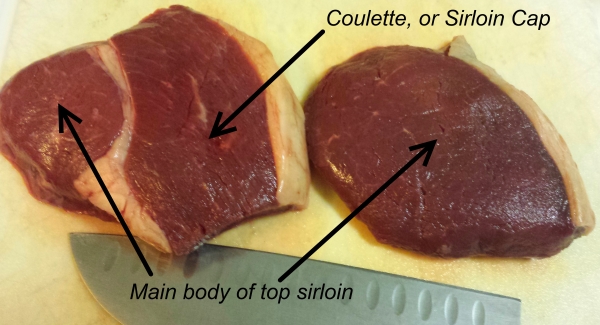
Unfortunately, Sir Loin is indeed the stuff of carnivore legends. If that indeed was true, he would have been married to Lady Coulette (you’ll see why in the video below!). In truth, the name does come from the ancient “Middle English surloine, which itself was derived from the Old French word surlonge, meaning sur la longe or above the loin” according to the perhaps trustworthy Wikipedia.
So…know that some folks even go so far as to call the center cut top sir as a Delmonico or even the coveted Chauteaubriand—these also are legends, lies and misnomers. Given all the nomenclature varieties, the top sir is a nice cut, but needs some special care when heat is applied.
The reason it often can become akin to boot leather is that it normally is cut a little thinner due to its moderate tenderness—so ours show up at around 1 inch in thickness. On an average steak where the butcher has cut perpendicular to the grain, heat application also means rapid drying due to the wicking effect. That means that when heat gets cranked up, so does the convective wicking effect of moisture up the fiber orientation of the steak. Moisture, juice, mouthfeel, and tenderness are lost quickly as it goes up in smoke and steam.
Unless…one is careful and moves quickly. What follows below is how I cook a Top Sirloin—and it works every time. This is the basic deal that we most often use on our own tasty meat. No fancy seasonings or marinades here. Some things to NOT do, or at least be VERY careful with:
- Don’t pound these with a mallet or tenderizer. What you’ll do is destroy those fragile muscle fiber walls and lose even more moisture than you would while cooking! We flash freeze these steaks to minimize cell wall damage and retain moisture…and flavor.
- Be very careful with marinades! They too, can dry a steak out, especially if they have a lot of sodium in the mix. What they often do is create an osmotic gradient and actually move moisture OUT of the steak resulting in flavor and tenderness loss!
- Same goes for salt! We usually save it for later. Cooking in a salty cover draws moisture out of the steak. This is a thin steak, and loss of moisture equals reduced tenderness and flavor (remember that flavor is transported across the tongue by moisture).
So, that said, here goes the top way to cook a top sirloin!
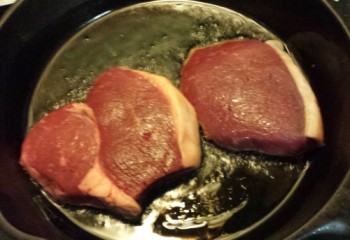
1.) Get those steaks warm. Room temp on the counter at least 45 minutes before cooking. We often forget that and submerge the vac packs under warm tap water for 30 mins. The reason for this is that often, folks will undercook the inside while jerkifying (read excessively drying) the exterior. Even pre-warming ensures even cooking.
2.) We cook most often on cast iron. A thick bottom fry pan or grill is fine too. Remember that a grill requires extra vigilance, and you need to resist hanging out with your buddies talking about that game, beer in hand.
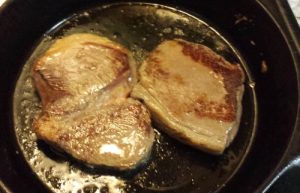
Probe with your index finger. Feel should be like the tip of your nose. Your cheek needs more time. Your chin is overdone.
3.) These fragile morsels require some quick attention, as the air flow effect on the grill carries moisture away 2x faster than any pan will. Cooking times are likely to be faster. Pick a cool part of charcoal, or turn the gas down to low.
4.) If pan frying, we use a little extra virgin olive oil or butter. Get the oil fairly hot, but not smoking.
5.) Drop those steaks on the pan or grill. Cook until light brown on bottom. Turn. Cook to light brown on reverse.
6.) Probe the steaks with your index finger. It should feel like touching the tip of your nose.
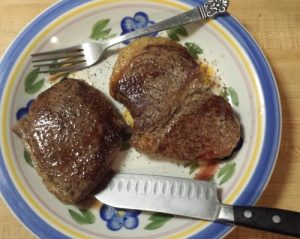
If it feels like touching your cheek it needs more time. If it feels like touching your chin it’s overdone (better luck next time). The ideal is between touching your nose and your cheek, unless you have a fat nose or bony cheek! If you are not comfortable probing the steak with your finger (it does take some practice), check the internal temperature with a probe type thermometer, and pull off the heat when the center temp is around 138 degrees F.
7.) Plate it, salt and pepper and cover. Let rest for 3-5 minutes.
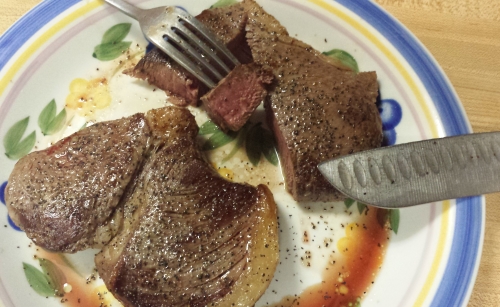
8.) Serve. Cut across the grain where you can when cutting into bite sized pieces. The beef should be pink, evenly through the whole steak profile.
A note on the coulette part: because of its longitudinal orientation, it will be much juicier—and that light pink found in the body of the sirloin steak will be a much deeper color with a lot of steak juice. It is why there is more apparent flavor and tenderness in the coulette portion.


 How to Make Gut Healing Bone Broth with Organic Beef Bones
How to Make Gut Healing Bone Broth with Organic Beef Bones
Great article. Thanks. I was a cook for over 25 years and have been cutting meat (including local grass-fed beef) for over 12 and I still like a little help and fresh ideas when I’m cooking. Going to follow this tonight, add some mushrooms and deglaze the pan with some red wine.